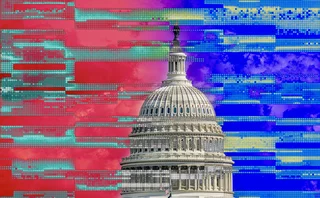EU trading venue definition could crush innovation, say bank execs
Firms worry that regulating a broader net of firms could unravel progress in fixed income electronification and raise costs for market participants

In late January, Europe’s markets regulator published its opinion on the definition of multilateral systems, asking for comment from the industry. The consultation lays out the European Securities and Markets Authority’s ideas on what constitutes such a trading venue and the firms that would need to seek authorization.
Banks are worried that if Esma’s definition is too broad and captures a wide net of vendors, it could ratchet up the cost of trading, stifle innovation in fixed income, and quash momentum in the electronification of the market, which is already lagging behind other asset classes.
“Forcing everyone to be regulated as a trading venue is going to increase the costs of doing business for the whole industry,” says Matthew Coupe, director of market structure for Europe, the Middle East and Africa at Barclays. “Fundamentally, when you’re looking at market structure impacts or debates, the first thing you need to look at is, what is the benefit to the end investor? I don’t think there is any benefit—it’s just reducing innovation.”
Esma’s consultation follows its final report on the functioning of organized trading facilities (OTFs) and multilateral trading facilities (MTFs), as part of a wider review of the Markets in Financial Instruments Directive (Mifid II). In this report, Esma said it would clarify its definition of multilateral systems and the trading venue perimeter to provide guidance to market participants. With the January consultation, it is seeking views from the industry on its analysis. Based on the responses it receives, the regulator will publish a final report and its opinion in the third quarter of this year.
The US is engaged in an analogous exercise. Just two days before Esma published its draft opinion, the US markets regulators published a consultation on amendments to the trading venue regulation that could bring more entities within the definition of an exchange.
As WatersTechnology reported last year, the trading perimeter is a hotly debated issue in the EU. Market operators such as MarketAxess, Tradeweb, and Bloomberg, which are registered MTFs, argue that a cohort of tech firms are eating into their businesses by mimicking trading venues without an authorized license. They have lobbied the European Commission via the Electronic Debt Markets Association to regulate this group of electronic vendors.
None of the three fixed income venues or Edma responded to a request for comment in time for publication of this article.
The trading venues believe that the firms encroaching on their turf include execution management systems (EMSs) and vendors such as Neptune, a provider of pre-trade bond data; Virtu Financial’s multi-asset request-for-quote hub; OTCX, an RFQ platform for derivatives; and GMLX, an electronic securities financing platform.
On the flip side, these vendors either dispute that they fall in scope of Mifid II or say the regulation is overreaching. They are concerned that if Esma enforces the current broad interpretation of what constitutes a trading venue, a swath of vendors ranging from EMSs to RFQ providers—and even chat applications, among many other types of business—could be captured by Mifid II. In the US, for instance, chat provider Symphony was forced to suspend its Sparc business pending talks with the Commodity Futures Trading Commission about obtaining a license to become a swap execution facility.
Heavy burden
Firms registered as venues in the EU would have to apply to Esma for authorization to become an MTF or OTF. Being a regulated entity comes with a long list of responsibilities, such as hiring heads of compliance and building out compliance teams, interpreting regulations, establishing compliance checks, reporting data, and adhering to regulatory requests.
One senior executive at a European bank says their firm worries that trading fixed income will become more expensive if the venue perimeter is widened. They say that if EMSs and the emerging cohort of electronic platforms in the market become regulated, the cost of compliance will just translate to higher service fees for clients.
“This will have a major impact on costs for dealers, but also for clients because regulated trading venues will need to have stronger compliance and control functions than a software provider,” says the bank executive.
Monica Summerville, head of capital markets at research and tech advisory firm Celent, says tech vendors would have to learn how to interpret EU principles-based rules and then embark on their path to compliance—an expensive and data-driven commitment.
“They would have to look at what reporting they must do, find out where to get the data, and create the system for it. But there are always going to be exceptions; there are always going to be problems with your reports. That will be an ongoing operational expense that they will have to undertake as they monitor changes to the regulations,” she says.
One step forward, two steps back
Barclays’ Coupe says widening the trading venue perimeter could inhibit electronification in fixed income trading. Some investment firms, for instance, might roll back their use of electronic platforms and return to more traditional methods of trading, such as phoning counterparties directly or communicating via turrets, rather than having to pay trading fees to go through venues. Couple says making electronic processing more expensive causes the industry to regress instead of pushing it in the direction of greater transparency.
“What we need to be looking at is, what is happening in terms of the evolution in the marketplace? Is electronic trading itself, by default, trading on a venue? Because I don’t think that is, or should be, the case,” he says.
Coupe also says it is still not fully clear what Esma’s definition is. In its consultation, the regulator says Mifid II introduced OTFs as a new kind of venue, with the intention of capturing a wider set of venues than the original directive—all multilateral systems that bring together multiple third-party buyers and sellers to interact and trade securities.
One concern among critics is that a small universe of tech systems and chat applications could unintentionally be drawn into scope of that definition. Coupe says a trading venue could even be said to encompass a dealer board or a telecom network provider. Nor is the definition restricted to fixed income—it could capture tech vendors or new entrants in the equity and foreign exchange markets.
“In the consultation paper, they also say that it’s not just about an electronic system; it’s about the system as a whole. So where do we draw the line with this?” he says.
Vendors and EMSs might not be the only firms impacted. Buy-side firms and systematic internalizers (SIs), investment firms that trade on their own account, might be discouraged from building out or enhancing in-house systems that allow them to buy or sell trades electronically, says the senior executive at the European bank.
“SIs may have to stay voice only, and will never be able to reduce manual error costs by implementing any automation in terms of pricing negotiation or trade notification,” they say.
A new phase
WatersTechnology spoke with two EMS providers for this article, FlexTrade and another firm that wished to remain anonymous. Both are still considering what action to take, but they say that in light of Esma’s opinion paper it is likely they will have to register as trading venues.
Esma says that once the consultation is over and it has published its final report in Q3, competent authorities in each jurisdiction can use it to assess on a case-by-case basis whether firms operating under their aegis should be registered as trading venues. The consultation period closes on April 29.
Some, however, believe the regulator has already made up its mind.
“It feels like the end. It doesn’t feel like this is a consultation paper. It feels very much like they are saying, ‘Enough of the discourse—this is what’s going to happen,’” says Andrew Mahoney, managing director at FlexTrade.
Mahoney says FlexTrade currently is not built to function as a regulated entity in this regard—the firm was founded and operates as a software provider. But it will have to adapt to whatever changes the regulator throws at it, he says, though it hasn’t firmed up any actions yet.
Any electronic system providing bilateral trading will end up having to register as a trading venue if Esma’s opinion is solidified as it stands, Mahoney adds. “It doesn’t seem like there is the possibility of not being regulated somewhere along the line. If you have bilateral connectivity, it has to be regulated somewhere.”
A senior executive at the second EMS provider says the firm will also probably have to register as a venue if the draft opinion becomes finalized, but adds that it will try to absorb the cost of compliance, rather than passing it on to clients.
“We will just have to eat the cost—it’s as simple as that,” they say.
A new world
Over the past few years, investment firms have begun to develop bilateral connections to other counterparties. These systems that they use to trade or communicate bilaterally could also be pulled into scope of Esma’s definition. For bilateral trading to continue electronically, Mahoney says, a new kind of third party could emerge.
One suggestion being floated by market participants is to develop a kind of utility that could register as an MTF, he says. This utility would function as a compliant “wrapper” or “proxy” to which investment firms could connect directly and route their bilateral trades to and from their counterparties.
“The problem with that approach is, who is that MTF? Who is that overseeing body who runs that venue? And do they do it for profit? How does it work?” Mahoney says.
Byron Cooper-Fogarty, chief operating officer of Neptune, says that from his reading of Esma’s opinion, the tech provider will not have to become an authorized venue. However, the publication has given the vendor pause for thought about developing any bilateral capabilities directly in the future. It wouldn’t make commercial sense for Neptune to become an MTF, he says.
“I think it would certainly stifle any plans to do things directly because a lot of the bilateral execution elements perhaps don’t warrant the expense and work required to become an MTF. So that’s why we wouldn’t consider doing something like that,” he adds.
Rather, he says, Neptune might look to partner with one or more EMSs in the future.
Further reading
Only users who have a paid subscription or are part of a corporate subscription are able to print or copy content.
To access these options, along with all other subscription benefits, please contact info@waterstechnology.com or view our subscription options here: http://subscriptions.waterstechnology.com/subscribe
You are currently unable to print this content. Please contact info@waterstechnology.com to find out more.
You are currently unable to copy this content. Please contact info@waterstechnology.com to find out more.
Copyright Infopro Digital Limited. All rights reserved.
As outlined in our terms and conditions, https://www.infopro-digital.com/terms-and-conditions/subscriptions/ (point 2.4), printing is limited to a single copy.
If you would like to purchase additional rights please email info@waterstechnology.com
Copyright Infopro Digital Limited. All rights reserved.
You may share this content using our article tools. As outlined in our terms and conditions, https://www.infopro-digital.com/terms-and-conditions/subscriptions/ (clause 2.4), an Authorised User may only make one copy of the materials for their own personal use. You must also comply with the restrictions in clause 2.5.
If you would like to purchase additional rights please email info@waterstechnology.com
More on Regulation
Off-channel messaging (and regulators) still a massive headache for banks
Waters Wrap: Anthony wonders why US regulators are waging a war using fines, while European regulators have chosen a less draconian path.
Banks fret over vendor contracts as Dora deadline looms
Thousands of vendor contracts will need repapering to comply with EU’s new digital resilience rules
Chevron’s absence leaves questions for elusive AI regulation in US
The US Supreme Court’s decision to overturn the Chevron deference presents unique considerations for potential AI rules.
Aussie asset managers struggle to meet ‘bank-like’ collateral, margin obligations
New margin and collateral requirements imposed by UMR and its regulator, Apra, are forcing buy-side firms to find tools to help.
The costly sanctions risks hiding in your supply chain
In an age of geopolitical instability and rising fines, financial firms need to dig deep into the securities they invest in and the issuing company’s network of suppliers and associates.
Industry associations say ECB cloud guidelines clash with EU’s Dora
Responses from industry participants on the European Central Bank’s guidelines are expected in the coming weeks.
Regulators recommend Figi over Cusip, Isin for reporting in FDTA proposal
Another contentious battle in the world of identifiers pits the Figi against Cusip and the Isin, with regulators including the Fed, the SEC, and the CFTC so far backing the Figi.
US Supreme Court clips SEC’s wings with recent rulings
The Supreme Court made a host of decisions at the start of July that spell trouble for regulators—including the SEC.







